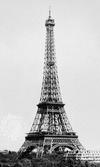- Eiffel Tower
-
a tower of skeletal iron construction in Paris, France: built for the exposition of 1889. 984 ft. (300 m) high.[named after A. G. EIFFEL, its engineer and principal designer]
* * *
Parisian landmark built for the Centennial Exposition of 1889.Conceived by the bridge engineer Gustave Eiffel (1832–1923), the 984-ft (300-m) tower of open-lattice wrought iron was a technological masterpiece. Making use of advanced knowledge of the behavior of metal arch and truss forms under loading, the structure presaged a revolution in civil engineering and architectural design. The tower was the world's tallest building until completion of the Chrysler Building in 1930. The Eiffel Tower, Paris, designed by Gustave Eiffel, 1887–89.Giraudon/Art Resource, New York
The Eiffel Tower, Paris, designed by Gustave Eiffel, 1887–89.Giraudon/Art Resource, New York* * *
French Tour EiffelParisian landmark that is also a technological masterpiece in building-construction history. When the French government was organizing the International Exposition of 1889 to celebrate the centenary of the French Revolution, a competition was held for designs for a suitable monument. More than 100 plans were submitted, and the Centennial Committee accepted that of the noted bridge engineer Gustave Eiffel (Eiffel, Gustave). Eiffel's concept of a 984-foot (300-metre) tower built almost entirely of open-lattice wrought iron aroused amazement, skepticism, and no little opposition on aesthetic grounds. When completed, the tower served as the entrance gateway to the exposition.Nothing remotely like the Eiffel Tower had ever been built; it was twice as high as the dome of St. Peter's in Rome or the Great Pyramid of Giza. In contrast to such older monuments, the tower was erected in only about two years (1887–89), with a small labour force, at slight cost. Making use of his advanced knowledge of the behaviour of metal arch and metal truss forms under loading, Eiffel designed a light, airy, but strong structure that presaged a revolution in civil engineering and architectural design. And, after it opened to the public on March 31, 1889, it ultimately vindicated itself aesthetically.The Eiffel Tower stands on four lattice-girder piers that taper inward and join to form a single large vertical tower. As they curve inward, the piers are connected to each other by networks of girders at two levels that afford viewing platforms for tourists. By contrast, the four semicircular arches at the tower's base are purely aesthetic elements that serve no structural function. Because of their unique shape, which was dictated partly by engineering considerations but also partly by Eiffel's artistic sense, the piers required elevators to ascend on a curve; the glass-cage machines designed by the Otis Elevator Company of the United States became one of the principal features of the building, helping establish it as one of the world's premier tourist attractions.The tower itself is 300 metres (984 feet) high. It rests on a base that is 5 metres (17 feet) high, and a television antenna atop the tower gives it a total elevation of 324 metres (1,063 feet). The Eiffel Tower was the tallest man-made structure in the world until the topping off of the Chrysler Building in New York City in 1929.* * *
Universalium. 2010.
